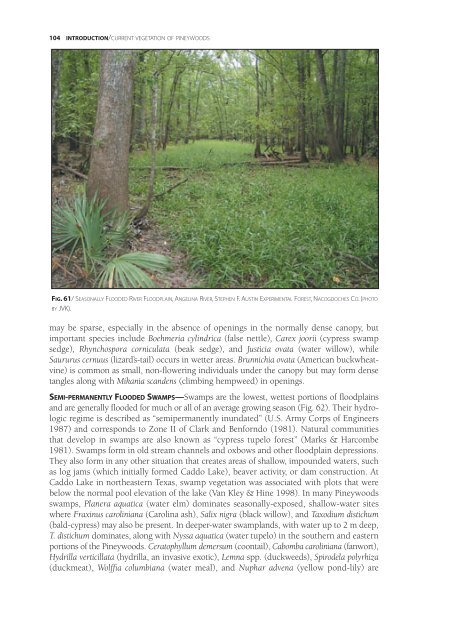ILLUSTRATED FLORA OF EAST TEXAS - Brit - Botanical Research ...
ILLUSTRATED FLORA OF EAST TEXAS - Brit - Botanical Research ...
ILLUSTRATED FLORA OF EAST TEXAS - Brit - Botanical Research ...
You also want an ePaper? Increase the reach of your titles
YUMPU automatically turns print PDFs into web optimized ePapers that Google loves.
104 INTRODUCTION/CURRENT VEGETATION <strong>OF</strong> PINEYWOODS<br />
FIG.61/SEASONALLY FLOODED RIVER FLOODPLAIN,ANGELINA RIVER,STEPHEN F. AUSTIN EXPERIMENTAL FOREST,NACOGDOCHES CO.(PHOTO<br />
BY JVK).<br />
may be sparse, especially in the absence of openings in the normally dense canopy, but<br />
important species include Boehmeria cylindrica (false nettle), Carex joorii (cypress swamp<br />
sedge), Rhynchospora corniculata (beak sedge), and Justicia ovata (water willow), while<br />
Saururus cernuus (lizard’s-tail) occurs in wetter areas. Brunnichia ovata (American buckwheatvine)<br />
is common as small, non-flowering individuals under the canopy but may form dense<br />
tangles along with Mikania scandens (climbing hempweed) in openings.<br />
SEMI-PERMANENTLY FLOODED SWAMPS—Swamps are the lowest, wettest portions of floodplains<br />
and are generally flooded for much or all of an average growing season (Fig. 62). Their hydrologic<br />
regime is described as “semipermanently inundated” (U.S. Army Corps of Engineers<br />
1987) and corresponds to Zone II of Clark and Benforndo (1981). Natural communities<br />
that develop in swamps are also known as “cypress tupelo forest” (Marks & Harcombe<br />
1981). Swamps form in old stream channels and oxbows and other floodplain depressions.<br />
They also form in any other situation that creates areas of shallow, impounded waters, such<br />
as log jams (which initially formed Caddo Lake), beaver activity, or dam construction. At<br />
Caddo Lake in northeastern Texas, swamp vegetation was associated with plots that were<br />
below the normal pool elevation of the lake (Van Kley & Hine 1998). In many Pineywoods<br />
swamps, Planera aquatica (water elm) dominates seasonally-exposed, shallow-water sites<br />
where Fraxinus caroliniana (Carolina ash), Salix nigra (black willow), and Taxodium distichum<br />
(bald-cypress) may also be present. In deeper-water swamplands, with water up to 2 m deep,<br />
T. distichum dominates, along with Nyssa aquatica (water tupelo) in the southern and eastern<br />
portions of the Pineywoods. Ceratophyllum demersum (coontail), Cabomba caroliniana (fanwort),<br />
Hydrilla verticillata (hydrilla, an invasive exotic), Lemna spp. (duckweeds), Spirodela polyrhiza<br />
(duckmeat), Wolffia columbiana (water meal), and Nuphar advena (yellow pond-lily) are
















